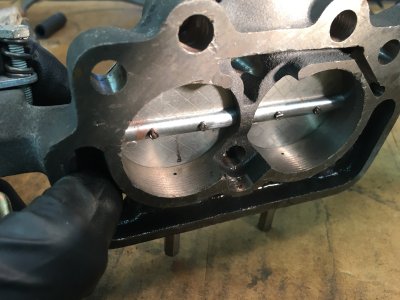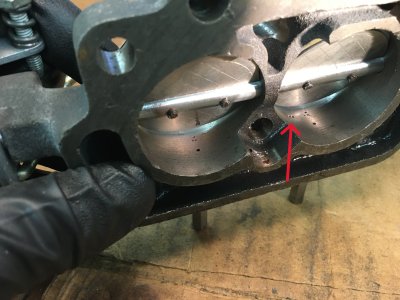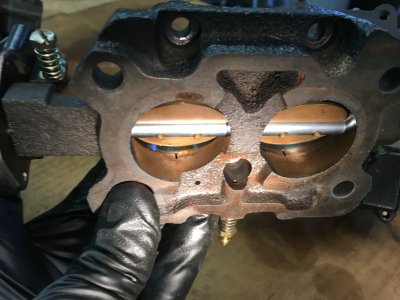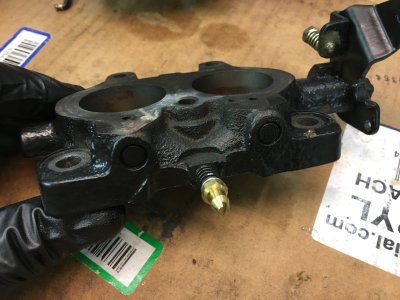If I degree a small six cam and it is right on, I assume that I made a mistake, and check again and find I did.
You are using an out of date browser. It may not display this or other websites correctly.
You should upgrade or use an alternative browser.
You should upgrade or use an alternative browser.
All Small Six Which cylinder head?
- Thread starter Otto
- Start date
This relates to all small sixes
A compression test would indicate erroneous valve timing or potential valve sealing problem, if the rings are good.Today I tried some things. I re-gapped the plugs to 0.035” as Frank suggested with no real joy. I did check the rear valve cover breather for vacuum signal and there was a little, I’m hesitant to call it vacuum, but it would draw a piece of paper towards it- not very strong at all. The brass fittings in the adapter have an ID of ~0.25” at most and in some areas it appears less.
Everything I try seems to have no effect or the engine runs worse, so I had to step away and just crack a beer.
I again checked for vacuum leaks with propane and found none. Putting propane into the carb would pick up a little RPM, but not smooth out the engine. The additional fuel was read by the AFR meter.
The engine just has a miserable idle and what sounds like a constant misfire well into the RPM range, so I can’t help thinking there is some underlying issue here, but don’t know what it is. All components seem to function properly, but the engine is not happy. Ignition?, thinking of substituting a TFI coil on the shelf.
Another thought I have is when I assembled the engine, I degreed the assumed stock camshaft to specs in the Falcon Performance Handbook. It was off about 12 degrees with the assumed stock timing chain set the engine came with and I installed the CI adjustable double roller set to match the timing events in the handbook. I’ve degreed camshafts before, but the thought that I F’d this up somehow sticks in the back of my head.
I guess I failed to mention earlier that I bought this “rebuilt” engine at an auction and went through it when I got it home. So all the parts are new, but I didn’t purchase them.
I owned an early Mustang quite some time ago that had a rebuilt 200, and it idled so smoothly you could set a wine glass on the air cleaner. I realize this thread has gone from a simple question of cylinder heads to where it is now, but I do appreciate the help.
Did you check the degrees of duration when degreeing? Knowing the profile would be helpful. . . My last cam install the cam was off 5* AND the 3-key timing gear was off. Supposed to be 4* change, was 6*.
I could try a compression test to see if the engine has too much cylinder pressure or low pressure, or maybe it's just right.
What I did when the engine was assembled, was match the timing events published in the Falcon Handbook for a stock cam. It's within a few degrees. The camshaft was in the engine when I purchased it and brand new, like the rest of the engine, but specs are unknown. LIft was comparable to a stock cam- I don't know the duration profile but guess it's likely stock also.
Would a few degrees +/- make the engine idle roughly? It's more of a misfire than the rough idle of a lumpy cam. It makes good power for its size up to 4000 RPM w/2bbl.
What I did when the engine was assembled, was match the timing events published in the Falcon Handbook for a stock cam. It's within a few degrees. The camshaft was in the engine when I purchased it and brand new, like the rest of the engine, but specs are unknown. LIft was comparable to a stock cam- I don't know the duration profile but guess it's likely stock also.
Would a few degrees +/- make the engine idle roughly? It's more of a misfire than the rough idle of a lumpy cam. It makes good power for its size up to 4000 RPM w/2bbl.
I could try a compression test to see if the engine has too much cylinder pressure or low pressure, or maybe it's just right.
What I did when the engine was assembled, was match the timing events published in the Falcon Handbook for a stock cam. It's within a few degrees. The camshaft was in the engine when I purchased it and brand new, like the rest of the engine, but specs are unknown. LIft was comparable to a stock cam- I don't know the duration profile but guess it's likely stock also.
Would a few degrees +/- make the engine idle roughly? It's more of a misfire than the rough idle of a lumpy cam. It makes good power for its size up to 4000 RPM w/2bbl.
My understanding is that the amount of camshaft advance is going to be divided by the turns of the crankshaft (one for every two rotations of the crank), so a degree or two advanced on a mild or stock engine isn’t going to be massive detriment and I don’t think it’s going to be enough of an issue to cause the idle to have a misfire.
For a misfire, I would look at my timing to make sure my initial advance isn’t too much.
This is unlikely but the other thing I’d look at is my valvetrain to make sure I have enough clearance when the valves are supposed to be closed. I’m not sure if your valvetrain is adjustable; mine is not and if I shaved my head or zero decked my block, I’d need a different (shorter) set of pushrods to allow the valves to close.
Yes ^^ . And a manifold vacuum reading would be helpful in diagnosis. both timing and valve sealing.For a misfire, I would look at my timing to make sure my initial advance isn’t too much.
Again- this would be quickly verified by a compression test.This is unlikely but the other thing I’d look at is my valvetrain to make sure I have enough clearance when the valves are supposed to be closed. I’m not sure if your valvetrain is adjustable;
Possibly lumpy if it's retarded, but a misfire- no.Would a few degrees +/- make the engine idle roughly? It's more of a misfire than the rough idle of a lumpy cam.
The most important spec in degreeing a cam is verification of actual #1 TDC. If that is off, every other measurement is erroneous.
Was able to get back to the van after the holiday and check a few things.
Performed a compression test as suggested and also because I was curious. Readings were 160-165 psi across all cylinders- this was expected as the engine has ~300 miles from new. I no longer feel the cam timing is an issue. The engine idles at 18” of Hg with a steady needle. The timing mark on the dampner was verified correct when the engine was assembled.
I warmed the engine up before the test and checked the timing. With the vacuum disconnected, the initial is set at 12* btc. With the vacuum connected, it’s at 34* btc at idle- seems like a lot. When I was bouncing between vacuum and no vacuum to the distributor, the idle was much smoother with the vacuum disconnected. It wasn’t what I would call perfect, but it was acceptable.
So I'm not sure how to proceed with this. With the vacuum advance disconnected, I can live with the idle but would be giving up economy and drivability. With the vacuum advance connected, the idle is so objectionable it’s miserable to drive and the engine stalls easily. If I set the initial timing back further with the vacuum connected, the engine runs even worse.
The carb performs very well with the exception of the idle situation with the vacuum advance connected to the manifold. I would really like to see this work.
Performed a compression test as suggested and also because I was curious. Readings were 160-165 psi across all cylinders- this was expected as the engine has ~300 miles from new. I no longer feel the cam timing is an issue. The engine idles at 18” of Hg with a steady needle. The timing mark on the dampner was verified correct when the engine was assembled.
I warmed the engine up before the test and checked the timing. With the vacuum disconnected, the initial is set at 12* btc. With the vacuum connected, it’s at 34* btc at idle- seems like a lot. When I was bouncing between vacuum and no vacuum to the distributor, the idle was much smoother with the vacuum disconnected. It wasn’t what I would call perfect, but it was acceptable.
So I'm not sure how to proceed with this. With the vacuum advance disconnected, I can live with the idle but would be giving up economy and drivability. With the vacuum advance connected, the idle is so objectionable it’s miserable to drive and the engine stalls easily. If I set the initial timing back further with the vacuum connected, the engine runs even worse.
The carb performs very well with the exception of the idle situation with the vacuum advance connected to the manifold. I would really like to see this work.
It sounds like you're using manifold vacuum for advance. Does your distributor call for it? My new Progression Ignition distributor does, but I fired it up for the first time today and haven't measured the total advance yet. That does seem like a lot of advance at idle.
Last edited:
Hey Otto, glad to get this report. And glad to solve the idle issue. Yes 30+ degrees of idle timing is nothing short of unacceptable. You're 'tween a rock and hard place.The marine carburetors typically don't feature ported vacuum, so the only option is manifold vacuum. The DSll distributor is connected to the manifold.
Many vacuum advance canisters are adjustable. 22* of advance may be ok for that engine, it's too much for a 300.
Really need ported vacuum here. . . The only non-compromise solution.
Frank, please elaborate on this; is it possible to adjust it so there is minimal advance at idle but near the total amount the engine would be happy with at cruising speed? Or is this just wishful thinking?Many vacuum advance canisters are adjustable. 22* of advance may be ok for that engine, it's too much for a 300.
This, ^^ unfortunately. The total advance may be adjustable. That's not the issue, when it's active is.Or is this just wishful thinking?
Ported vacuum is really ideal. And was the first vacuum advance designed- contrary to what some have erroneously posted in the past. Ported = no advance at idle, and rapid application of advance to manifold pressures just off idle.
I've been running it thru my head how to create one on that carb. It would require drilling a passage, and that -just right. Not really viable. Or possibly slotting the throttle blade directly inline with the current port under the blade. Also, can't determine viability without seeing it.
Excessive timing advance is hard on crank bearings, and increases piston skirt wear. It's not hard to visualize- the piston is moving slowly at idle, fuel burns at (nearly) a constant rate. Lighting the fire before the rod has had time to reach the apex creates excessive pressure- "unacceptable".
Have you examined the carb bore closely? Wonder if there is a port and passage for ported cast in, just plugged. It would be a hole or small slot just above the throttle blade on the upper leading edge, with the throttle closed on base idle.
Good point Frank, I’ve thought of this myself. I dug out other 2G carbs on the shelf that do have ported vacuum ports to see how this was facilitated.Have you examined the carb bore closely? Wonder if there is a port and passage for ported cast in, just plugged. It would be a hole or small slot just above the throttle blade on the upper leading edge, with the throttle closed on base idle.

With the throttle blades closed, the idle mixture holes are visible.

Cracking the blades a little, other very small holes are uncovered. You can see a trio of small holes in both barrels, and a couple of slightly larger holes in one barrel. I traced these to what appears to be a vacuum hose port. On the carburetor base there is a plug that seems to coincide with these holes. I see a similar plug on the van’s carb. Tomorrow I’ll take that one apart and see if that is the case with the Mercarb.
It’s interesting that the ported vacuum port only seems to be located in one of the carb’s throats. It might be possible to drill an insanely small hole with incredible precision and land the hole just above the throttle blade. It would be great to just make ported vacuum happen!
x
Good research!! I was going to dig one out myself to look, but my wife's 100% from-scratch pizza took precedent. The red arrow is pointing at the distributor vacuum source. If the marine unit has those portholes and it can be tracked to a blank or plug on the exterior, you'll be in business. Only needs to be in one barrel. All it does is let the closed throttle block manifold vacuum. Distributor vacuum is 0 until the edge of the throttle gets high enough to allow air to pass over the port holes, then the distributor sees intake manifold vacuum. Jumps from 0"-18" or whatever the intake vac is at that moment, instantly, not gradually. Light load needs the increased advance, idle needs none. Ported carburetor vacuum works precisely. Hope you can unleash it in the Marine unit.Good point Frank, I’ve thought of this myself. I dug out other 2G carbs on the shelf that do have ported vacuum ports to see how this was facilitated.
View attachment 24340
With the throttle blades closed, the idle mixture holes are visible.
View attachment 24341
Cracking the blades a little, other very small holes are uncovered. You can see a trio of small holes in both barrels, and a couple of slightly larger holes in one barrel. I traced these to what appears to be a vacuum hose port. On the carburetor base there is a plug that seems to coincide with these holes. I see a similar plug on the van’s carb. Tomorrow I’ll take that one apart and see if that is the case with the Mercarb.
It’s interesting that the ported vacuum port only seems to be located in one of the carb’s throats. It might be possible to drill an insanely small hole with incredible precision and land the hole just above the throttle blade. It would be great to just make ported vacuum happen!
x
PS- spraying compressed air, brakeclean, etc into a porthole or exterior vacuum nipple can verify where it leads to on the other end.
I was able to remove the Mercarb and see if ported vacuum was a possibility. What I see are slots that are above the butterflies, but covered when they are closed.


These appear to be part of the carb’s circuits; when I spray WD-40 up these holes, it comes out near the top of the venturi. I’m not sure there would be enough signal here to provide vacuum to the distributor (and may interfere with what the carb is trying to do to run the engine). If this was possible, one of these plugs could be tapped for a fitting.

I’m no carb expert, but thinking this might not work. I will defer to those more knowledgeable than myself to determine that.
There still may be a path forward for ported vacuum. It also may be possible to drill through the base where the red line is and place a very small hole at or just above the throttle blade to connect the distributor.

x


These appear to be part of the carb’s circuits; when I spray WD-40 up these holes, it comes out near the top of the venturi. I’m not sure there would be enough signal here to provide vacuum to the distributor (and may interfere with what the carb is trying to do to run the engine). If this was possible, one of these plugs could be tapped for a fitting.

I’m no carb expert, but thinking this might not work. I will defer to those more knowledgeable than myself to determine that.
There still may be a path forward for ported vacuum. It also may be possible to drill through the base where the red line is and place a very small hole at or just above the throttle blade to connect the distributor.

x
The slots are part of the idle circuit.
They are transition slots to supply fuel as the carburetor transitions from idle to the main boosters.
You will have to drill a hole just above a closed throttle plate to the outside as you are suggesting.
They are transition slots to supply fuel as the carburetor transitions from idle to the main boosters.
You will have to drill a hole just above a closed throttle plate to the outside as you are suggesting.
Yes you can drill where the red line is. Don't touch the slots, the carb will be ruined.
The exact location of the hole into the airhorn relative to the closed throttle will determine when vacuum advance comes in. A few hundreths of an inch will make a big difference. If it is too far above the blade, advance will be delayed, and you will have soggy light throttle drivability. It needs to be as close to the blade as possible without being so close it is getting a vacuum signal at closed throttle. . Remember to be sure the throttles are on the base idle screw. Same as when it was on the engine, idling hot. Not the high choke idle, or fully closed blades.
If you err, err high. the hole can be elongated downward toward the throttle blade edge. If you come in too close to the blade, can't be corrected.
The smaller the port hole, the stronger the signal will be at the distributor. Make the thru hole small (like the factory holes), and then counter drill/tap for the nipple.
The exact location of the hole into the airhorn relative to the closed throttle will determine when vacuum advance comes in. A few hundreths of an inch will make a big difference. If it is too far above the blade, advance will be delayed, and you will have soggy light throttle drivability. It needs to be as close to the blade as possible without being so close it is getting a vacuum signal at closed throttle. . Remember to be sure the throttles are on the base idle screw. Same as when it was on the engine, idling hot. Not the high choke idle, or fully closed blades.
If you err, err high. the hole can be elongated downward toward the throttle blade edge. If you come in too close to the blade, can't be corrected.
The smaller the port hole, the stronger the signal will be at the distributor. Make the thru hole small (like the factory holes), and then counter drill/tap for the nipple.
Last edited:
Thanks for the support & affirmation of this guys, I really want this to work.
The other carbs have vacuum port holes inside the throat that are approximately 0.045", so I've ordered some materials that will allow me to drill that tiny hole. I'm nervous about drilling it already.
The other carbs have vacuum port holes inside the throat that are approximately 0.045", so I've ordered some materials that will allow me to drill that tiny hole. I'm nervous about drilling it already.
The base is cast iron.If that base is cast iron - and not alloy, you will have a hard time drilling with a small drill bit.
Maybe drill with a 1/8" bit but not all the way thru and do the last 40thou with your small drill bit
...measure depth twice , drill once....
My plan was to do as you describe, doing the majority of the drilling with a larger bit. So it's like you're reading my mind!
Similar threads
All Small Six
Winter Project: Better breathing with a large log
- Replies
- 100
- Views
- 3K
- Replies
- 21
- Views
- 4K
- Replies
- 1
- Views
- 562
All Small Six
Any Large Log Head Blueprints Available?
- Replies
- 4
- Views
- 1K
- Replies
- 6
- Views
- 978
